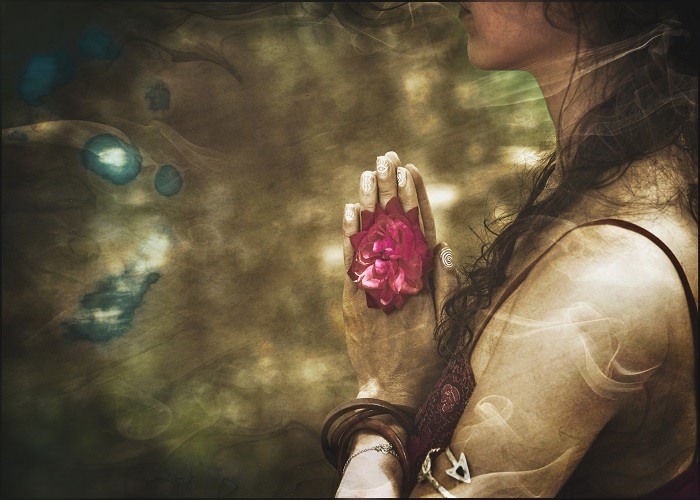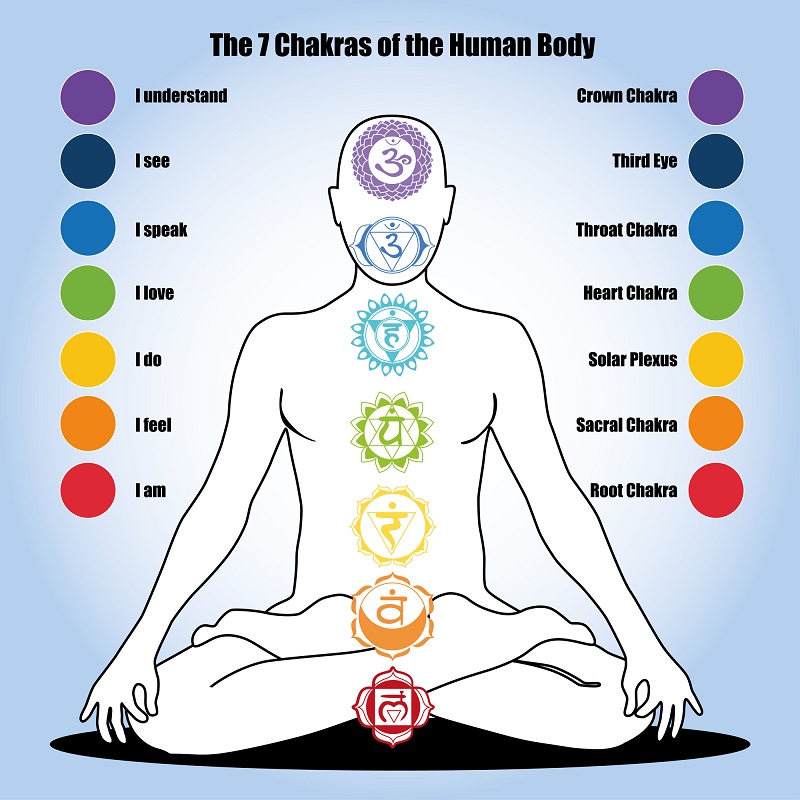
Article at a Glance The Hara chakra, also known as the sacral Hara chakra, is an energy center located in the pelvic region of the body that holds our relational, creative, and sexual energies. The hara line is an invisible axis that anchors the flow of energy within us, and it is responsible for directing the flow of energy through each major point along the spine. When in balance, the hara chakra helps us feel in touch with our purpose and potential, safe and secure in our sexuality, creative expression, and relationships with others. Practices such as sacral-focused meditation, expressive dancing, artistic expression, positive affirmations, color or gemstone therapy, sound therapy, and specific yoga asanas can help activate the hara chakra. A hara chakra meditation involves visualizing an amber glow in the pelvic region and allowing it to bring the sacral energy into balance. The hara chakra holds plenty of potential for growth and healing, empowering, inspiring, and vitalizing our being.
The body is the vehicle, consciousness the driver. Yoga is the path, and the chakras are the map. Anodea Judith
When we hear about the seven major energy centers of the body, certain familiar names come to mind.
Chances are, the ‘hara chakra’ is not one of those names, and yet you are likely familiar with the energy that this chakra embodies.
As we explore the energetic body in greater depth, we come across different teachings and traditions that point towards new understandings about the chakra system.
The hara chakra and the associated hara line are two of those ancient knowings you might stumble upon when taking a closer look.
As we explore the hara chakra, you’ll tune into understandings you might already hold about another common chakra, Swadhisthana.
On top of it, you’ll gain deeper insights into the creative, dynamic potential we each carry nestled within our sacral region.
What is the Hara Chakra?
The hara chakra, sometimes called the sacral hara chakra, is more or less parallel to the energy point commonly referred to as Swadhisthana – or simply, the sacral chakra.
This energy center holds our relational, creative, and sexual energies as it sits within the pelvic region of the body.
Through this point we engage dynamically and powerfully with the external world.
The difference in terminology comes from various traditions having both tapped into this energetic point in the body.
Stemming from ancient India, this energy center is known as Swadhisthana.
When looked at through the Japanese tradition, we find it referred to as ‘hara’.
In Japanese, hara refers to the lower abdomen or belly – and it is this point that is believed to be the center of our energy force.
In Japanese, this energy force is known as ki (or chi). The same energetic force is referred to as prana in Indian traditions.
So, regardless of the tradition we examine this energy point from, the sacral or hara chakra is the energy point responsible for our dynamic, creative, and passionate engagement with life.
It is a gateway into a deeper understanding of our oneness with all of life’s energetic displays.
What is the Hara Line?

When we explore the hara chakra, we are likely to bump into another term: the hara line.
What is the hara line?
Well, if we consider that each of our major chakras takes in and gives out energy to those above and below, we might consider that something must direct that flow.
According to ancient Japanese wisdom, the hara line is this container, an invisible axis that subtly directs, or anchors, the flow of energy within us.
In yogic tradition, this axis is called sushumna.
It runs through the center of the body from root to crown, channeling energy through each major point along the spine.
When chakras are balanced, energy flows freely and we experience a great sense of peace and equanimity.
Since the hara is said to be the center of our energy force, it makes sense that the axis which transmits this energy is called the hara line.
So, as energy enters our body, it uses this axis as its highway, ascending and descending as it is divinely guided.
Hara Chakra Properties
The hara chakra holds many similarities to the sacral chakra.
However, while it is also regarded as being within the belly or navel region, it also carries traces of what are commonly considered to be solar plexus qualities.
Some of the major properties of this energy point include:
Hara chakra location: Located within the pelvis or sacral region, just beneath the navel.
Hara chakra color: Orange or amber
Hara chakra gemstones: Citrine, orange calcite, tiger’s eye
Themes: Creativity, intimacy, sexuality, vitality, purpose, passion, emotions, pleasure
Messages: Heighten your awareness of the ever-present flow of energy; Tune into your creative potential; Consider the dynamics of the energy you share with others; Explore the joy of life; Follow your bliss or your passion
Affirmations: I am aware of my aliveness; I am attuned with my life’s purpose; I give myself permission to embrace pleasure; I am creative and inspired; I am one with the force of life; The world is beautiful, abundant, and joyful
When in balance, the hara chakra is responsible for us feeling in touch with our purpose and our potential.
It helps us to feel safe and secure in our sexuality, in our creative expression, and in our relationships with others.
When open to the flow of chi or prana, we feel little separation from ourselves and the world around us.
When this chakra is overactive, we can find ourselves feeling emotionally unbalanced, insecure, co-dependant, and lacking a sense of self-fulfillment.
Mood swings, anxiety, excessive attachment, and addictions may also appear.
On the other hand, a blocked hara chakra (or one that is underactive) can lead to an inability to express ourselves creatively, fear or judgment of pleasure, lack of motivation or energy, confusion about our purpose, apathy, or attachment issues.
As we tune into our unique needs, beliefs, and energy patterns at present, we gain a sense of how well energy is moving along the hara line through the sacral chakra and every other point.
By exploring a variety of hara chakra healing practices, we begin to balance the life force as it flows through this part of our being.
Overtime, we open ourselves up to its fullest potential.
Activating the Hara Chakra
There are a variety of practices that are beneficial for activating the hara chakra.
By activating it (or any other chakra for that matter), we want to consider that activation might involve either an increase or a decrease in energy.
In some cases, activating will help us to stimulate dormant energy.
In other cases, ‘activation’ might resemble a slowing down of energy. Why?
Because more is not necessarily better.
It is possible for any chakra to be in excess, and in these cases, bringing it back to balance helps to activate its true potential and purpose.
There are a variety of sacral practices to consider that help us to effectively explore and express the energetic potential of this energy center.
Some of these practices include:
- Sacral-focused meditation: By focusing on the sacral region or lower belly during meditation, we tune into this energetic center and unconsciously begin to open to its potential. These meditations often include some form of visualization, whether that involves colour, swirling energy, or some other imagery.
- Expressive dancing: Getting into our bodies creatively and dynamically is one great way to tap into the life force within us. Conscious, expressive dancing is about moving intuitively and with curiosity. It is about celebrating and witnessing the dynamic force of life in each movement.
- Artistic expression: Expression through painting, drawing, or some other artistic form can help us to unleash our creativity. As we unleash our creativity, even if it feels unfamiliar at first, we strengthen positive beliefs surrounding the notion that we are innately creative beings. We start to feel more confident in expressing who we are.
- Positive affirmations: Another way to strengthen these positive beliefs is through affirmations. Affirmations such as, “I am a divinely creative being,” “I grant myself permission to embrace pleasure,” and “I am aware of my aliveness” help us to stimulate any dormant energy in the sacral or hara chakra. Affirmations can also help us to bring excess energy into balance.
- Color or gemstone therapy: Meditating on the colour orange, using crystals and gemstones during meditation, and even eating vibrant, orange foods can help us to open and heal the hara chakra. Stones often associated with this region of the body include orange calcite, tiger’s eye, and citrine.
- Sound therapy: Each chakra corresponds with a particular sound known as a bija or seed mantra. The bija mantra associated with the sacral or hara chakra is “VAM”. This can be listened to through audio recordings or guided meditations; or, it can be chanted on one’s own to help cleanse and balance the hara chakra.
- Specific yoga asana practice: Since yoga taps into various energetic pathways in the body, specific poses can help to balance or activate our chakras. Poses associated with positively influencing the sacral chakra include Malasana, Supta Baddha Konasana, and Ananda Balasana. These hip-opening poses target the area around the sacral and can cause emotions to come to the surface. In cases of trauma, start with more gentle hip openers, such as a seated version of Baddha Konasana.
Hara chakra healing takes time.
Depending on our personal experiences, beliefs, and various other factors, the degree to which this area needs to be balanced will vary.
Take your time to explore this area, remaining patient and compassionate with yourself as things shift.

Hara Chakra Meditation

This hara chakra meditation is one meditation that is focused on balancing the energies of the sacral.
Explore it as frequently as you like, taking it slowly as this region of the body is known to hold many of our strong emotions.
1. To begin, bring yourself to a comfortable seated position either cross-legged on the floor, kneeling, or in a straight-backed chair. Allow your arms and legs to rest comfortably as you close your eyes and begin to ground yourself through the breath.
2. Before we bring our attention to the hara region, it is important to ground ourselves into the space we occupy. Take about 60 seconds to root yourself. You can do this by feeling the physical space beneath you, by envisioning roots connecting you to the earth, or by watching your breath move all the way into the base of your spine.
3. Once you feel grounded and relaxed, shift your attention to sacral area, just an inch or two beneath the navel. Focus on this area as you continue to breathe deeply into the base of the belly.
4. Spend 30 to 60 seconds breathing this way, watching your breath move into and out of this region of the body. Without consciously doing anything, you are bringing this energetic center into balance.
5. If you notice any contraction or tension in your hips or belly, gently soften them as often as is required. Tension stored in these areas is often tied with an imbalance in the energy centers nearby, namely the hara or the solar plexus.
6. Now, envision a small, amber pearl appearing in this region of the body. Feel its warmth and its radiance as it slowly begins to grow larger, eventually filling the entire pelvic region.
7. Continue to breathe deeply as you sense this amber glow naturally bringing your sacral energy into balance. If you sense there is a stagnation in energy here, imagine that this orange orb is starting a small fire of passion, joy, and purpose within you. If you sense that you may be overactive in this chakra, imagine that this glow is dissolving any emotions, habits, or attachments that no longer serve you.
8. Spend anywhere from two to five minutes allowing this small fire to burn away what is no longer necessary and spark new inspiration, energy, or passion where it is most needed.
9. Gently allow the light to dim, returning your attention to the natural rhythm of your breath for three full cycles.
10. Before opening your eyes and returning to the outside world, choose a hara chakra affirmation that applies to you. Repeat this affirmation three times silently and slowly.
11. Allow the mind to return to your inner silence for as long as you need before gently opening your eyes and returning to the world around you.

Strong emotions often arise during meditation, and a sacral or hara meditation is certainly no exception to this.
The hips are known to be holders of our unprocessed emotions so exploring any energetic work in this area can bring these to the surface.
Ensure that you have whatever support you need to help you heal and balance these energies.
Take your time and practice self-compassion throughout any meditative journey or other healing work.
All in all, the hara chakra holds plenty of potential for our growth and healing.
Strongly associated with the sacral, it governs our emotions, our creativity, our sexuality, and our vitality.
As the hara is the center of our energy force, exploring it helps us to grow into deeply empowered, inspired, and vital expressions of our being.
Through activating the hara chakra, we grow into the wisdom that we are one with all of life – that the force of life we observe in the world around us is no different than the one that we embody.
By deepening our understanding of this, there’s no telling where this wisdom will take us.
Brain Power, Law of Attraction, Wealth, Weight Loss, Confidence
You may also be interested in: 1. The 8th Chakra [How to Awaken Our Soul Star Chakra] 2. Ear Chakra [Awakening Your Highest Hearing Potential] 3. Chakra Meditation [19-minute Guided Meditation] 4. What Does It Mean to Have a Blue Aura?
How do you know if your chakras are blocked? According to traditional Eastern beliefs, blocked chakras can manifest as physical, emotional, or spiritual imbalances. Some common symptoms of blocked chakras include physical pain, anxiety, depression, insomnia, lack of focus, and fatigue. If you suspect that your chakras are blocked, it's important to seek guidance from a qualified practitioner or healer who can help you identify and address the root cause of the blockage. Which chakra should you unblock first? It depends on the specific symptoms you are experiencing. However, according to traditional Eastern beliefs, the root chakra is considered the foundation of the chakra system and is therefore often recommended as the starting point for chakra healing. The root chakra is located at the base of the spine and is associated with feelings of safety, security, and grounding. When this chakra is blocked, it can lead to feelings of fear, anxiety, and disconnection from the physical body. By unblocking the root chakra, you may be able to restore a sense of stability and security, which can help to support the healing of other chakras.





